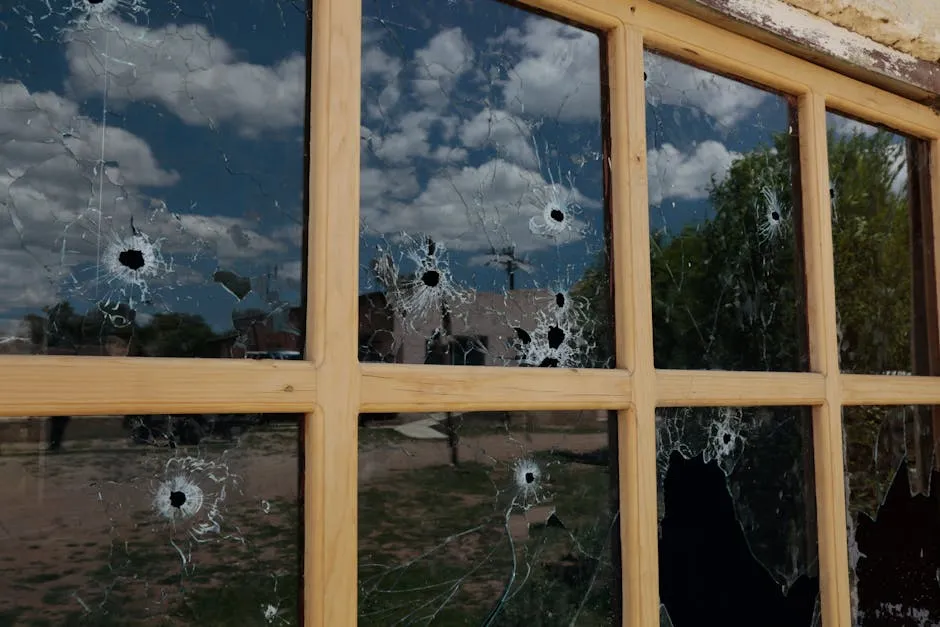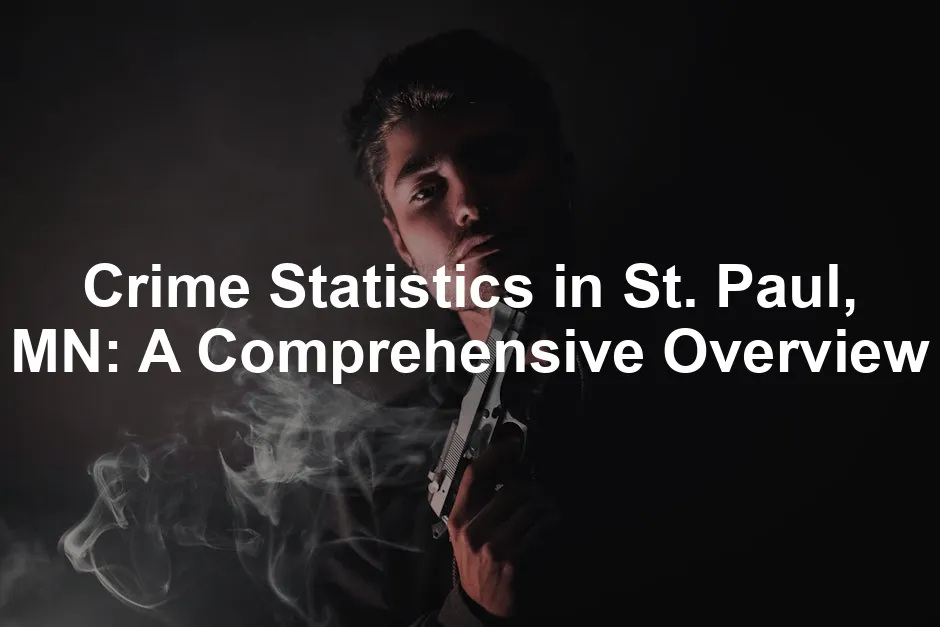Introduction
Understanding crime statistics is essential for anyone living in or considering a move to St. Paul, Minnesota. This article aims to provide a detailed analysis of crime statistics in St. Paul, comparing them to state and national averages. We will uncover the numbers that tell the story of safety in the city and how these statistics affect potential residents, current residents, and policymakers.
Why should you care about crime statistics? For starters, they provide insight into the safety of neighborhoods, helping individuals make informed decisions about where to live. Current residents can benefit from understanding trends, which can foster community vigilance and engagement. Policymakers rely on crime data to allocate resources efficiently and create effective crime prevention strategies. Knowledge is power, after all!
This article will cover several key topics:
- A definition of crime statistics and their significance.
- Sources of crime data, including the FBI and local law enforcement.
- The calculation of crime rates and their context.
- A detailed look at crime rates in St. Paul, including violent and property crime statistics.
- Neighborhood crime variations and comparisons with other cities.
The information provided here is designed to equip readers with a comprehensive view of crime in St. Paul, ensuring you’re well-informed and prepared for any move or decision regarding this vibrant city.

Understanding Crime Statistics
What are Crime Statistics?
Crime statistics are numerical representations of criminal activities within a specific area over a given time frame. These statistics are crucial for urban studies, as they provide insights into patterns and trends in crime. Understanding these statistics can help identify issues in society, such as socioeconomic factors that contribute to crime.
So, where do these numbers come from? The primary sources of crime data include the Federal Bureau of Investigation (FBI) and local law enforcement agencies. The FBI compiles data from thousands of law enforcement agencies across the nation, providing a comprehensive overview of crime trends. Local police departments also collect and report statistics, enhancing the granularity of the data. These sources help create a clearer picture of crime in specific areas, allowing for better community safety initiatives.
When examining crime statistics, it’s essential to understand that not all crimes are reported. Factors like underreporting, variations in definitions, and differences in local law enforcement practices can affect the accuracy of crime statistics. Thus, while these figures serve as a useful guideline, they should be interpreted with caution.
If you’re looking to delve deeper into the psychology behind criminal behavior, consider checking out The Psychology of Criminal Behavior by David J. V. Fisher. This book sheds light on the motivations behind crime, helping you understand the ‘why’ behind the statistics.

Crime Rate Calculation
Calculating crime rates is essential for understanding safety in any city, including St. Paul, Minnesota. Typically, crime rates are expressed per 100,000 people. This method allows for a standardized comparison between cities of different sizes. For instance, if St. Paul has 4,551 reported crimes per 100,000 residents, it provides a clearer picture than just stating the total number of crimes.
Understanding crime rates in context is crucial. Comparing St. Paul’s rates to Minnesota and national averages reveals how it stacks up against similar areas. This context helps residents and potential movers gauge whether a city is safe or if certain neighborhoods might be more problematic. It’s like comparing apples to apples rather than apples to oranges, and nobody likes a fruit salad that’s off.
For those interested in a comprehensive overview of crime-related literature, Crime and Punishment by Fyodor Dostoevsky is a classic that explores the psychological turmoil of crime and morality.

Crime Rates in St. Paul
Overview of Crime Rates
St. Paul faces significant crime challenges, with an overall crime rate of 4,551 incidents per 100,000 people. This figure is notably higher than both Minnesota’s average of 2,402 crimes per 100,000 and the national average of 2,324. In St. Paul, the violent crime rate stands at 749 per 100,000, while property crimes reach a staggering 3,803 per 100,000.
Breaking it down further, violent crimes include various offenses that can shake a community to its core. In 2022, St. Paul reported 2,127 violent crimes, including:
- Murder: 34 incidents (0.11 per 1,000 people)
- Rape: 242 incidents (0.80 per 1,000 people)
- Robbery: 413 incidents (1.36 per 1,000 people)
- Assault: 1,438 incidents (4.74 per 1,000 people)
Property crime rates are even grimmer, with a total of 12,915 property crimes reported. The breakdown reveals:
- Burglary: 1,506 incidents (4.97 per 1,000 people)
- Larceny (theft over $50): 8,220 incidents (27.11 per 1,000 people)
- Motor Vehicle Theft: 3,189 incidents (10.52 per 1,000 people)
When we compare these statistics to state and national averages, St. Paul’s figures show a stark reality. The violent crime rate in St. Paul is 169.9% higher than Minnesota’s average and 93.1% above the national average. Similarly, property crimes are 79% higher than the state average and 94.2% higher than the nation. It’s clear that residents need to be vigilant.

For a comprehensive analysis of crime in St. Paul, including Fremont crime statistics, check out this detailed report. fremont crime statistics
Violent Crime Statistics
Diving deeper into violent crime statistics, the numbers tell a story of concern. The total violent crimes in St. Paul have remained high, with a noticeable increase over the years. In 2020, the total violent crimes reached 2,320, and while there was a slight decline in 2021, the numbers remain elevated.
Looking at specific types of violent crime, the trends reveal a mixed bag. For example, while murder rates saw a minor fluctuation, the rates of assault and robbery have shown significant concern. The 1,438 assaults in St. Paul translate to a rate of 4.74 per 1,000 people, which is alarmingly high.
In terms of prevention and community response, St. Paul has recognized the need for improvement. Local law enforcement agencies have ramped up efforts to address these violent crime trends. Initiatives focused on community policing and enhancing public safety awareness aim to drive these numbers down.
Understanding the violent crime landscape in St. Paul is essential for residents and those considering a move to the city. Being informed is the first step in staying safe, and knowledge is certainly power in this case.

Property Crime Statistics
Property crime remains a pressing issue in St. Paul, MN. In 2022, the city reported a staggering total of 12,915 property crimes. Let’s break it down into specific categories that keep residents on their toes:
- Burglary: 1,506 incidents (4.97 per 1,000 residents)
- Larceny (theft over $50): 8,220 incidents (27.11 per 1,000 residents)
- Motor Vehicle Theft: 3,189 incidents (10.52 per 1,000 residents)
Now, if you think about it, those larceny numbers might give you pause before you leave your bike unattended at the coffee shop. While property crime rates in St. Paul have shown some fluctuation, there’s a noticeable trend. Over the past few years, the property crime rate has averaged around 3,803 incidents per 100,000 residents, consistently hovering above the state and national averages.
The community has seen efforts to reduce these numbers through various initiatives, yet the statistics suggest that vigilance is still necessary. Residents are encouraged to engage in neighborhood watch programs and take preventive measures to protect their belongings. If you’re looking for a comprehensive guide on criminal investigation, The Complete Idiot’s Guide to Criminal Investigation by Michael A. Palmer is a fantastic resource.

Year-over-Year Changes
When we take a closer look at the year-over-year changes in crime rates, the picture gets a bit clearer. In recent years, St. Paul has experienced a mixed bag of trends. While violent crimes showed a slight decline, property crimes have been on the rise. The total property crime count saw an increase of approximately 3.3% compared to the previous year, indicating that not all is well in the neighborhood.
Several factors contribute to these fluctuations. Economic conditions play a significant role; areas with high unemployment or economic distress often see spikes in property crime. Additionally, demographic shifts can influence crime rates. As populations change, neighborhoods may experience different social dynamics that can either exacerbate or alleviate crime issues.
A deeper understanding of these trends can help residents grasp the complexities of their local environment. Armed with this knowledge, they can better prepare themselves and their communities for potential challenges ahead. After all, being informed is the first step toward creating a safer environment for everyone.

Neighborhood Crime Analysis
Neighborhoods with Higher Crime Rates
St. Paul has its fair share of neighborhoods that keep residents on their toes. Here’s a look at the areas that often make the ‘not-so-safe’ list:
- Thomas Dale: This neighborhood is notorious, with a crime rate 84% higher than the St. Paul average. Residents often express concerns about safety, especially at night.
- Downtown St. Paul: With a vibrant atmosphere comes a darker side. The crime rate here is 78% above the city average, making it a hotspot for petty crimes and other illegal activities.
- Dayton’s Bluff: Once a serene suburb, it now has a crime rate 62% higher than the city average, prompting residents to stay vigilant.
- North End: Known for its community spirit, it also has a crime rate 43% higher than average, which raises red flags for potential residents.
- Payne Phallen: This neighborhood sees a 21% increase in crime compared to the city average, often making it a talking point among locals.
So, why do these neighborhoods see more crime? A mix of socioeconomic factors plays a role. Areas with higher poverty rates and limited access to education can create conditions ripe for crime. Additionally, the density of certain neighborhoods can foster opportunities for illegal activities. It’s a classic case of environment influencing behavior.

Crime Mapping
Crime maps are valuable tools for understanding safety in St. Paul. They visually represent crime rates and patterns across neighborhoods, allowing residents to see where to tread carefully.
Using interactive crime maps, residents can identify areas of concern. For instance, the central parts of St. Paul often show higher crime concentrations, while neighborhoods on the outskirts boast lower crime figures. Maps highlight hotspots for various crimes, from theft to violent offenses.
These crime visualizations are not just for statistics; they help residents make informed decisions. If you’re eyeing a neighborhood, a quick glance at the crime map might reveal whether your future home is next to a hotspot or a haven. It’s like having a ‘neighborhood safety crystal ball’—who wouldn’t want one of those?
In summary, understanding the crime landscape in St. Paul is crucial for anyone considering a move or even just navigating the city. Neighborhoods with higher crime rates often have underlying issues, while crime maps serve as crucial resources for ensuring personal safety. Stay informed and be aware; your safety might just depend on it!

Comparison with Other Cities in Minnesota
When it comes to crime statistics, St. Paul doesn’t exactly shine like a diamond. Compared to cities of similar size in Minnesota, like Rochester and Duluth, St. Paul’s crime rates stand out—though not in a good way.
For instance, Rochester has an overall crime rate of about 3,863 per 100,000 residents, significantly lower than St. Paul’s staggering 4,551. Duluth, another comparable city, offers a slightly better situation with crime rates around 3,205 per 100,000. This means that if you’re living in St. Paul, you’re facing a crime rate almost 18% higher than Rochester and a whopping 42% higher than Duluth! It’s like being in a high-stakes game of Who Knows Crime Better, and St. Paul just keeps drawing the short straw.
One notable trend is the difference in violent crime rates. St. Paul’s violent crime rate sits at 749 per 100,000, compared to Rochester’s 370 and Duluth’s 529. This indicates that St. Paul is not only more dangerous but also has a higher likelihood of residents experiencing violent crime. When you consider the property crime figures—3,803 per 100,000 in St. Paul versus 2,125 in Rochester and 2,102 in Duluth—the picture gets even grimmer.
In sum, St. Paul’s crime rates dwarf those of its neighbors, particularly in violent and property crime. If you’re weighing your options for a move, these statistics might make you think twice about calling St. Paul home.

Community Safety Initiatives
Local Law Enforcement Efforts
Local law enforcement plays a critical role in addressing crime in St. Paul. The St. Paul Police Department employs various strategies to combat crime rates, focusing on community policing and proactive measures. Community policing is like a warm hug from the police to the residents, aiming to build trust and collaboration. Officers work closely with community members to identify issues and implement solutions tailored to local needs.
One notable initiative is the “Safe Streets” program. This program aims to reduce crime hotspots through increased patrols and community engagement. Officers often host “Coffee with a Cop” events, inviting residents to chat over a cup of joe. It’s a great way to bridge gaps and foster open communication. After all, who can resist a good conversation over coffee?
In addition to these outreach programs, the department has launched educational campaigns focusing on crime prevention. They provide resources on how to secure homes, protect personal belongings, and stay vigilant. By empowering residents with knowledge, the police department fosters an environment where everyone plays a part in community safety.

Community Engagement
Engagement is key when it comes to improving safety in St. Paul. Programs like neighborhood watch groups have gained traction in recent years. Residents band together to keep an eye on their neighborhoods, reporting suspicious activities. It’s like a neighborhood game of “I Spy,” but with real stakes. And the best part? Residents often form lasting friendships while keeping their streets safe.
Community meetings also provide a platform for residents to voice concerns and share experiences. These gatherings help build a sense of camaraderie and encourage collective action. One resident from the Thomas Dale neighborhood shared how a community meeting led to the formation of a watch group that significantly reduced local crime. It’s a reminder that together, neighbors can stand strong against crime.
Another success story comes from the Highland Park area, where residents collaborated with local police to tackle rising property crime rates. The engagement led to increased patrols and heightened awareness, resulting in a notable decrease in incidents. This collaboration proves that when residents and law enforcement work hand-in-hand, they can create a safer environment for all.
If you’re interested in understanding the broader context of criminal justice, The Criminal Justice System: A Brief Introduction by Frank Schmalleger provides valuable insights into the intricacies of the system.
In conclusion, community safety initiatives in St. Paul highlight the importance of collaboration between law enforcement and residents. By fostering engagement, these programs not only address crime but also strengthen the bonds within the community—making St. Paul a place where safety is a shared responsibility.

Conclusion
In wrapping up our exploration of crime statistics in St. Paul, a clear picture emerges. The city grapples with an overall crime rate of 4,551 per 100,000 people, significantly surpassing both state and national averages. Violent crime, especially, poses a challenge, with rates soaring above those in comparable Minnesota cities.
The statistics are sobering, but they shouldn’t discourage residents or potential movers. Instead, they underline the need for ongoing community engagement and awareness. The collaboration between local law enforcement and residents plays a pivotal role in combating crime and fostering safety.
St. Paul has seen positive community initiatives, from neighborhood watch programs to proactive policing efforts, all aimed at making the city safer. However, these efforts require continuous participation from residents. Staying informed and involved is crucial.
So, what can you do? Engage with your neighbors, attend community meetings, and be proactive about safety. Together, we can create a neighborhood that not only addresses crime but also builds a vibrant, connected community. Stay vigilant, stay involved, and let’s work together for a safer St. Paul!

FAQs
Is St. Paul a safe place to live?
Safety in St. Paul can be a mixed bag. While some neighborhoods boast low crime rates, others face higher incidents. It’s essential to research specific areas. Overall, St. Paul’s crime rates are above state and national averages, but many residents feel safe with community engagement and active policing.
How does St. Paul handle crime prevention?
St. Paul utilizes community policing and proactive strategies to tackle crime. The police department fosters partnerships with residents through programs like neighborhood watch and community meetings. These initiatives aim to create a collaborative approach to fighting crime.
What should residents do to stay safe?
Residents can take several practical safety measures: – Join neighborhood watch programs. – Attend community meetings. – Ensure homes are secured with proper locks. – Stay vigilant and report suspicious activities. – Build relationships with neighbors for a stronger community.
Where can I access more detailed crime data?
For detailed crime reports and statistics, check local police department websites or use crime mapping tools. The City of St. Paul offers resources and crime incident data through their Open Information Portal, making it easy for residents to stay informed.
Please let us know what you think about our content by leaving a comment down below!
Thank you for reading till here 🙂
All images from Pexels




